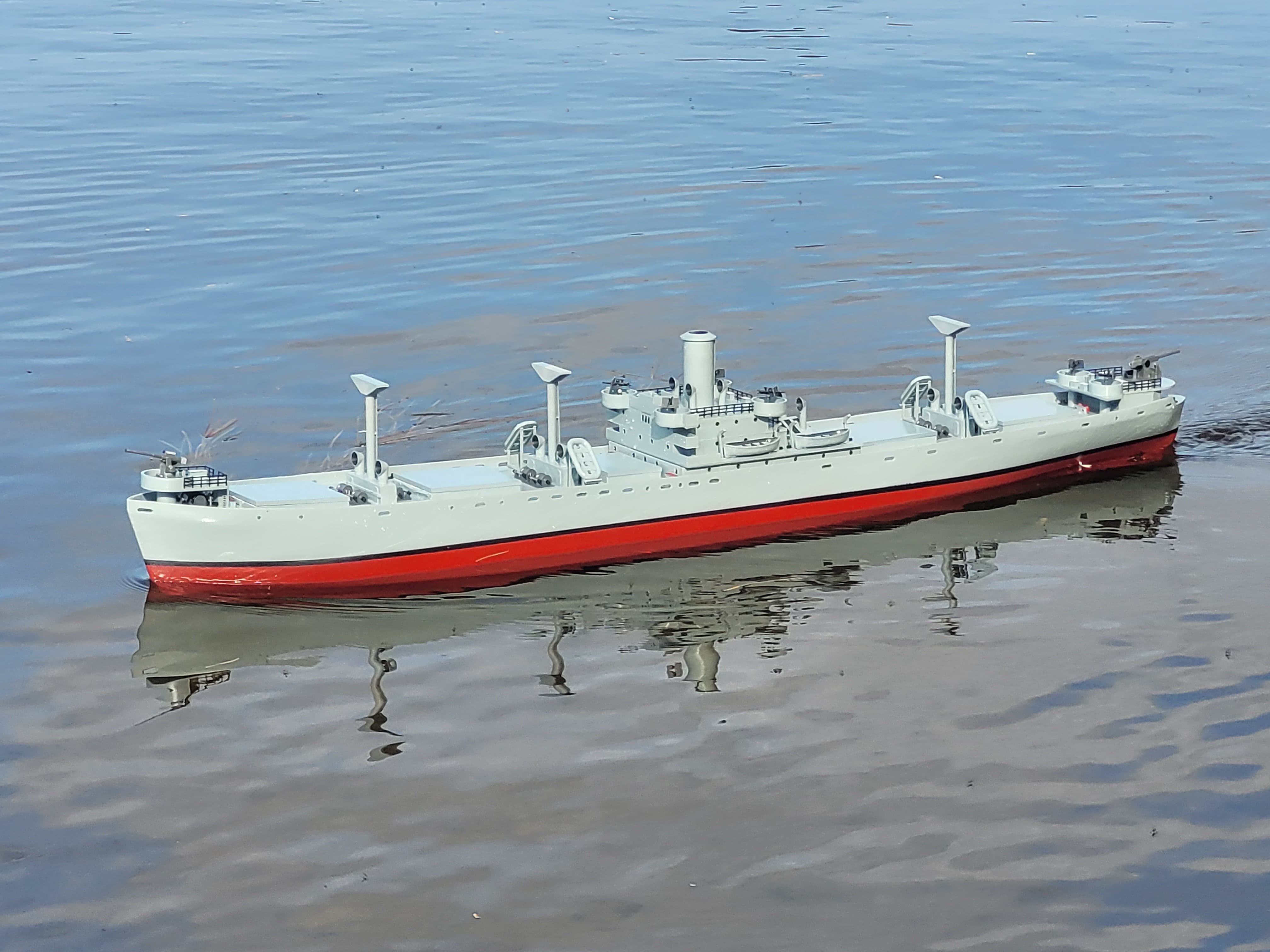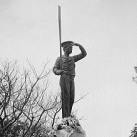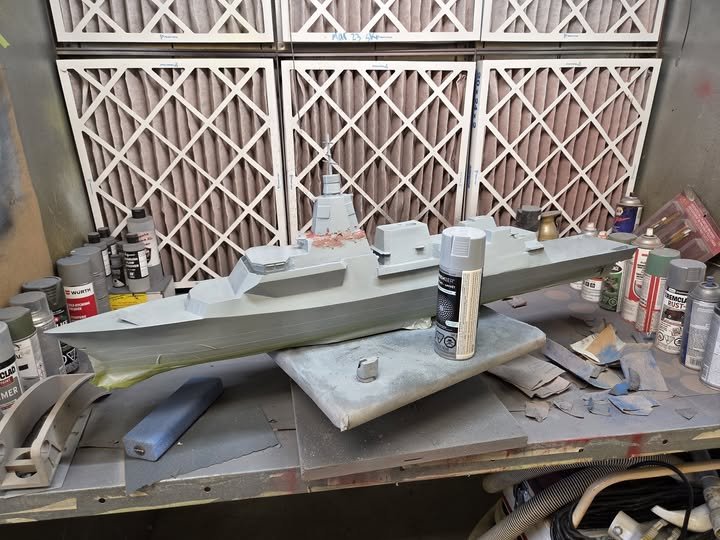-
Posts
646 -
Joined
-
Last visited
Profile Information
-
Gender
Male
-
Location
Windsor Junction, NS
Recent Profile Visitors
-
 GrandpaPhil reacted to a post in a topic:
Type 26 by NavyShooter - 3D Print - 1/144 - Display
GrandpaPhil reacted to a post in a topic:
Type 26 by NavyShooter - 3D Print - 1/144 - Display
-
I've got some 'ship's side gray' applied now - still needs sanding and touch-up, but it's getting there. I've been playing with the print files in the background - most of the walls on this model came in at less than 1mm. I've doubled that with the new version. One of the problems this set of stl files has when downloaded is that it has a lot of facets/triangles rather than a smooth hull form. I'm working to rectify that with a buddy who knows a thing or two. See how it goes.
-
 Canute reacted to a post in a topic:
Type 26 by NavyShooter - 3D Print - 1/144 - Display
Canute reacted to a post in a topic:
Type 26 by NavyShooter - 3D Print - 1/144 - Display
-
Another layer of bondo, and a bit more primer, and today's sanding saw me penetrate the plastic in one or two small spots. I rescued those with some superglue, but there is a limit to how much sanding that can be done....so....I'll do a light bit of touch-up next week (off to the field with the Army this weekend to play with drones and Carl Gustavs) and then I'll roll into masking and painting.
-
 FreekS reacted to a post in a topic:
MV/HMNLS Macoma 1935/1942 by FreekS - 1:144 - 3D-print - RADIO
FreekS reacted to a post in a topic:
MV/HMNLS Macoma 1935/1942 by FreekS - 1:144 - 3D-print - RADIO
-
You may well have seen a Swordfish under my name on TV.... BTW, I put up a tutorial on RCG in my USS Bodega Bay/HMS Puncher thread starting at post #30 on how to size and print aircraft for 1/144 scale RC Aircraft carriers. USS Bodega Bay - or...HMS Puncher? - Page 2 - RC Groups Have a peek - cutting the fuselage in half part-way then gluing it together will give decent results with less supports required in my experience. Your printer looks like it's got a bit of loose-ness in one axis result in those pronounced lines across the wings and tail - check your belt tension maybe? NS
-
 NavyShooter reacted to a post in a topic:
MV/HMNLS Macoma 1935/1942 by FreekS - 1:144 - 3D-print - RADIO
NavyShooter reacted to a post in a topic:
MV/HMNLS Macoma 1935/1942 by FreekS - 1:144 - 3D-print - RADIO
-
 NavyShooter reacted to a post in a topic:
Type 26 by NavyShooter - 3D Print - 1/144 - Display
NavyShooter reacted to a post in a topic:
Type 26 by NavyShooter - 3D Print - 1/144 - Display
-
 NavyShooter reacted to a post in a topic:
Good 'Hobby Quality' Metal Lathes
NavyShooter reacted to a post in a topic:
Good 'Hobby Quality' Metal Lathes
-
 tmj reacted to a post in a topic:
Good 'Hobby Quality' Metal Lathes
tmj reacted to a post in a topic:
Good 'Hobby Quality' Metal Lathes
-
 Mike Y reacted to a post in a topic:
Type 26 by NavyShooter - 3D Print - 1/144 - Display
Mike Y reacted to a post in a topic:
Type 26 by NavyShooter - 3D Print - 1/144 - Display
-
 Canute reacted to a post in a topic:
Type 26 by NavyShooter - 3D Print - 1/144 - Display
Canute reacted to a post in a topic:
Type 26 by NavyShooter - 3D Print - 1/144 - Display
-

Good 'Hobby Quality' Metal Lathes
NavyShooter replied to tmj's topic in Modeling tools and Workshop Equipment
Sounds to me as though you're looking for a Sherline or Unimat size/style lathe. I had a Sherline, and a Unimat, and found them small for the work I mostly do. I do hobby stuff, but metal work was mostly related to fire-stick linear projectile accelerator systems. If you catch my drift.... The Sher/Uni were both too small for my desires. I sold the Sher/Uni and got a used Southbend 10K from a high school sale, which I ended up selling to buy a Precision Matthews 10x30 lathe about 7 years ago. The SB was in rough shape - ways were demolished from 3 generations of kids dropping stuff on them. The PM doesn't have a quick change gear box for thread cutting, but it does have gears you can swap around to cut threads. It came with a QCTP and a variety of tooling. Runs on 120V, and does all I've asked it to do. It's not a business machine, it's a hobby machine, running it for 10 hours a day would be rough on it I think. Running it for a few hours on the weekend, and a couple nights a week? No problem. That said, since it sounds like size is the biggest concern you have, I'll suggest the Sherline, as it's got a lot of accessories available. Tooling is important and Sherline has oodles of it out there available. NS -
 NavyShooter reacted to a post in a topic:
Good 'Hobby Quality' Metal Lathes
NavyShooter reacted to a post in a topic:
Good 'Hobby Quality' Metal Lathes
-
 NavyShooter reacted to a post in a topic:
Type 26 by NavyShooter - 3D Print - 1/144 - Display
NavyShooter reacted to a post in a topic:
Type 26 by NavyShooter - 3D Print - 1/144 - Display
-
 Canute reacted to a post in a topic:
Type 26 by NavyShooter - 3D Print - 1/144 - Display
Canute reacted to a post in a topic:
Type 26 by NavyShooter - 3D Print - 1/144 - Display
-
 Canute reacted to a post in a topic:
Type 26 by NavyShooter - 3D Print - 1/144 - Display
Canute reacted to a post in a topic:
Type 26 by NavyShooter - 3D Print - 1/144 - Display
-
 Canute reacted to a post in a topic:
Type 26 by NavyShooter - 3D Print - 1/144 - Display
Canute reacted to a post in a topic:
Type 26 by NavyShooter - 3D Print - 1/144 - Display
-
 NavyShooter reacted to a post in a topic:
Renault FT-17 on a Renault FP artillery transporter by RGL - FINISHED - Meng/U-Models - PLASTIC/RESIN - diorama
NavyShooter reacted to a post in a topic:
Renault FT-17 on a Renault FP artillery transporter by RGL - FINISHED - Meng/U-Models - PLASTIC/RESIN - diorama
-
 NavyShooter reacted to a post in a topic:
Renault FT-17 on a Renault FP artillery transporter by RGL - FINISHED - Meng/U-Models - PLASTIC/RESIN - diorama
NavyShooter reacted to a post in a topic:
Renault FT-17 on a Renault FP artillery transporter by RGL - FINISHED - Meng/U-Models - PLASTIC/RESIN - diorama
-
 NavyShooter reacted to a post in a topic:
Renault FT-17 on a Renault FP artillery transporter by RGL - FINISHED - Meng/U-Models - PLASTIC/RESIN - diorama
NavyShooter reacted to a post in a topic:
Renault FT-17 on a Renault FP artillery transporter by RGL - FINISHED - Meng/U-Models - PLASTIC/RESIN - diorama
-
 NavyShooter reacted to a post in a topic:
Renault FT-17 on a Renault FP artillery transporter by RGL - FINISHED - Meng/U-Models - PLASTIC/RESIN - diorama
NavyShooter reacted to a post in a topic:
Renault FT-17 on a Renault FP artillery transporter by RGL - FINISHED - Meng/U-Models - PLASTIC/RESIN - diorama
-
 NavyShooter reacted to a post in a topic:
Renault FT-17 on a Renault FP artillery transporter by RGL - FINISHED - Meng/U-Models - PLASTIC/RESIN - diorama
NavyShooter reacted to a post in a topic:
Renault FT-17 on a Renault FP artillery transporter by RGL - FINISHED - Meng/U-Models - PLASTIC/RESIN - diorama
-
This is a damn fine project! Well done! I think I need to learn Fusion 360....there are a few projects I would like to have a go at. NS
-
You can see in the images from the designer, he's got the hull cut into modules already - but, when I downloaded the files, he'd gone a step further and cut these parts 'apart' even more into a port/stbd half, and split the superstructure in parts as well. I re-assembled the parts in the slicer, and printed them as 'complete' modules, so I've got 8 modules, with some small superstructure bits for the radar mast printed separately.
-
Ahoy gents, Another project is underway - I decided to try and make a 3D printed Type 26 Destroyer. I first came across the file set last year on CGTrader. I paid the $25 for it, and regretted it. The seller indicated that it was not suitable for R/C, but I decided to try anyhow....and....it's not suitable. The details are wrong for the RCN version - missile layouts are incorrect, superstructure is incorrect - particularly the main mast. Here's the link: Type 26 City Class Frigate 3D print model 3D model 3D printable | CGTrader The designer is not a modeler, and is not well versed in what an RC model needs to have - the hull is very thin, the superstructure is not designed to be easily removed with a raised lip to keep water out, there's no shaft line holes, nor a rudder hole. Overall, it is not well suited to make a good physical model with. The designer also used a program to generate the files that leaves triangular facets on the model. Everywhere. Large triangles, small triangles...it's not a smooth hull at all. It's very blocky. All that said, I want to make a Type 26...and this is about all I've found out there that's partway suitable. So. here we go.
-
Ian, The Castle is indeed in the background - there's a build thread for her here as HMCS St Thomas, printed at 1/48 scale Size - comfortable - she's about 4.5 feet or so - and weight is probably 15 pounds? Ish? As for 'cutting' a file in the slicer program (like Bambu Studio) I have instructions on how to use the feature in the Prusa slicer on page 3 of this thread: USS Bodega Bay - or...HMS Puncher? - Page 2 - RC Groups
- 51 replies
-
- Puncher
- escort carrier
-
(and 1 more)
Tagged with:
-
Ian, yes, she started her career with 4x twin 3"50 guns, but during one of her refits, they removed the forward sponsons and closed in some of the forward boat bays, reducing her to 2x twin 3"50. The boat bays were closed in because the ship's boats and other equipment was getting excessive damage due to the waves coming into the forward bays. The ship also had 3x 6 pounder Saluting Guns on the quarterdeck. The RCN still uses the same saluting guns today.
About us
Modelshipworld - Advancing Ship Modeling through Research
SSL Secured
Your security is important for us so this Website is SSL-Secured
NRG Mailing Address
Nautical Research Guild
237 South Lincoln Street
Westmont IL, 60559-1917
Model Ship World ® and the MSW logo are Registered Trademarks, and belong to the Nautical Research Guild (United States Patent and Trademark Office: No. 6,929,264 & No. 6,929,274, registered Dec. 20, 2022)
Helpful Links
About the NRG
If you enjoy building ship models that are historically accurate as well as beautiful, then The Nautical Research Guild (NRG) is just right for you.
The Guild is a non-profit educational organization whose mission is to “Advance Ship Modeling Through Research”. We provide support to our members in their efforts to raise the quality of their model ships.
The Nautical Research Guild has published our world-renowned quarterly magazine, The Nautical Research Journal, since 1955. The pages of the Journal are full of articles by accomplished ship modelers who show you how they create those exquisite details on their models, and by maritime historians who show you the correct details to build. The Journal is available in both print and digital editions. Go to the NRG web site (www.thenrg.org) to download a complimentary digital copy of the Journal. The NRG also publishes plan sets, books and compilations of back issues of the Journal and the former Ships in Scale and Model Ship Builder magazines.














